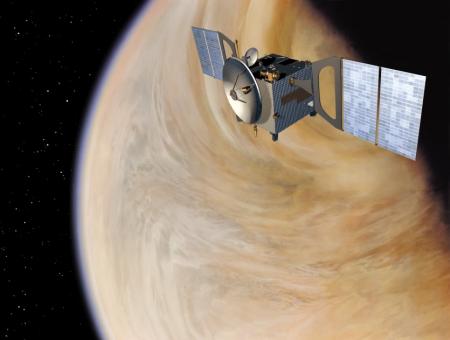ESA spacecraft sees ''eerie glow'' in night-time atmosphere of Venus
 Paris, Feb 25: ESA's (European Space Agency's) Venus Express spacecraft has observed an eerie glow in the night-time atmosphere of Venus, which is infrared light coming from nitric oxide.
Paris, Feb 25: ESA's (European Space Agency's) Venus Express spacecraft has observed an eerie glow in the night-time atmosphere of Venus, which is infrared light coming from nitric oxide.
This is showing scientists that the atmosphere of Earth''s nearest neighbor is a temperamental place of high winds and turbulence.
Unfortunately, the glow on Venus cannot be seen with the naked eye because it occurs at the invisible wavelengths of infrared.
ESA''s Venus Express, however, is equipped with the Visible and Infrared Thermal Imaging Spectrometer (VIRTIS) instrument, which can see these wavelengths.
VIRTIS has made two unambiguous detections of the so-called nightglow for nitric oxide at Venus.
This is the first time such infrared detections have been made for any planet and provide a new insight into Venus''s atmosphere.
"The nightglow can give us a lot of information," said Antonio Garcia Munoz, who was at the Australian National University when the research was carried out.
"It can provide details about the temperature, wind direction, composition and chemistry of an atmosphere," he added.
The nightglow is ultimately caused by the Sun''s ultraviolet light, which streams into a planet''s atmosphere and breaks the molecules up into atoms and other simpler molecules.
On the night-side, where atoms are transported by a vigorous diurnal circulation, the glow can be seen with appropriate instruments, such as VIRTIS.
A nitric oxide nightglow in the infrared has never been observed in the atmospheres of Mars or Earth, although it is known that the necessary nitric oxide molecules are present because they have been observed in ultraviolet.
The nightglow on Venus has been seen at infrared wavelengths before, betraying oxygen molecules and the hydroxyl radical, but this is the first detection of nitric oxide at those wavelengths.
It offers data about the atmosphere of Venus that lies above the cloud tops at around 70 km.
The oxygen and hydroxyl emissions come from 90-100 km, whereas the nitric oxide comes from 110-120 km altitude.
Yet, even VIRTIS cannot see the nitric oxide nightglow all the time because it is often just too faint.
"Luckily for us, Venus has a temperamental atmosphere. Packets of oxygen and nitrogen atoms are blown around," said Garcia Munoz.
Sometimes, these become dense enough to boost the brightness of the nightglow, making it visible to VIRTIS.
The VIRTIS team plans to continue monitoring the planet, building up a database of this fascinating phenomenon. (ANI)